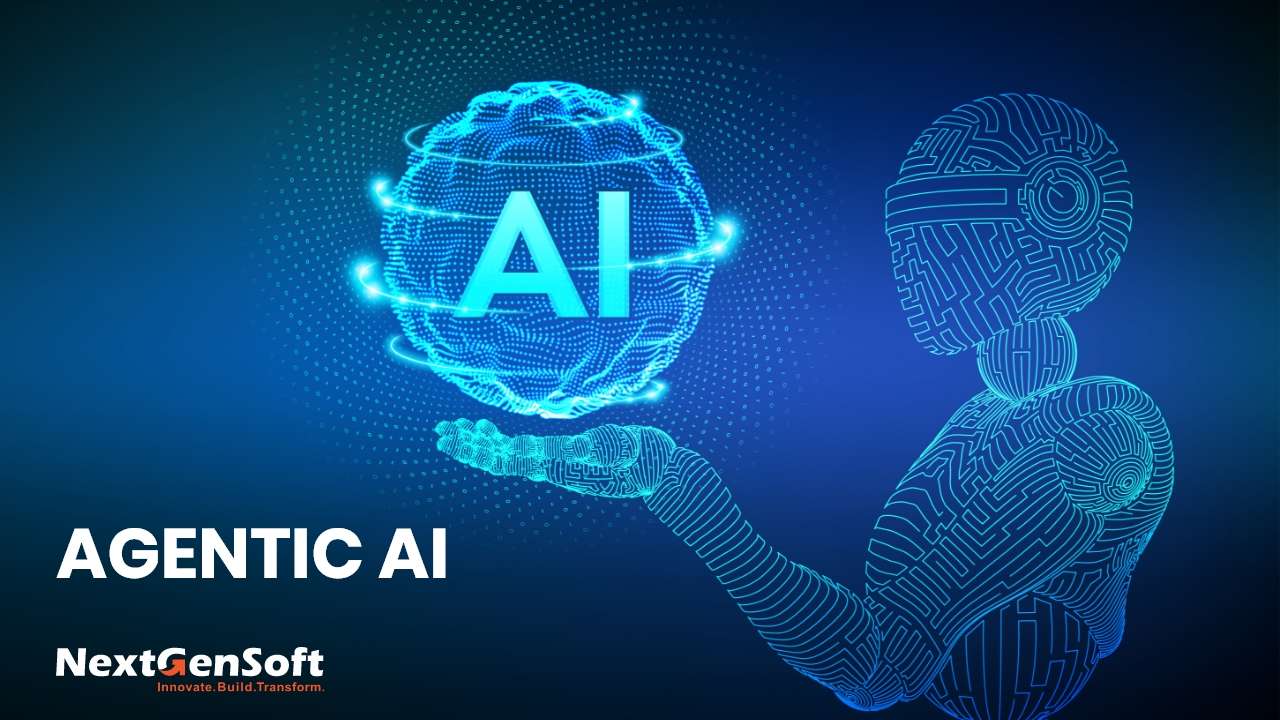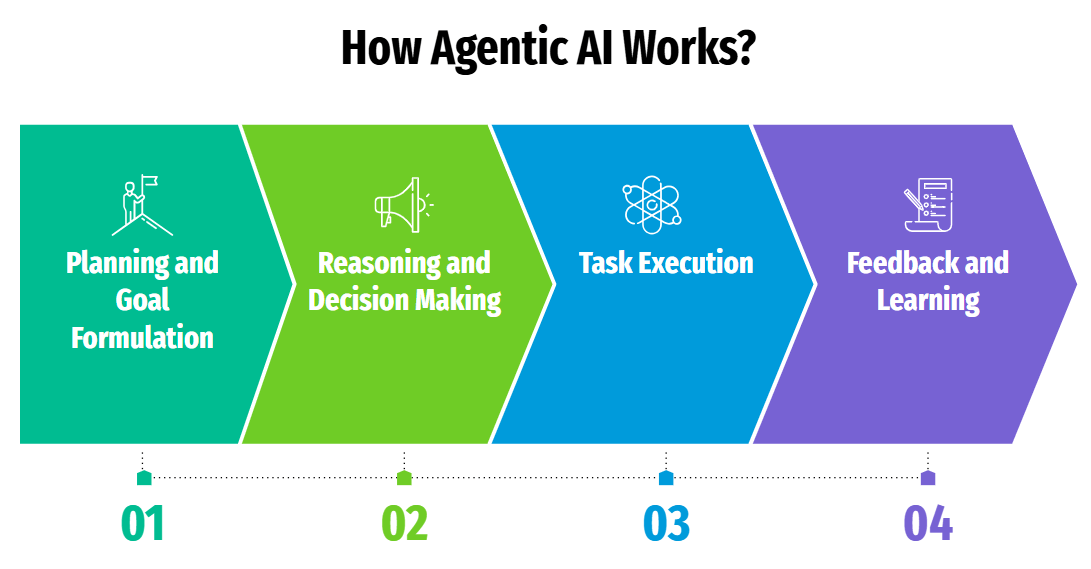

Table of Contents
Artificial Intelligence (AI) is quickly evolving, and Agentic AI is the latest advancement disrupting the AI ecosystem. While traditional AI models are reactive and typically focused on specific tasks (i.e., a narrow assignment), Agentic AI systems are meant to act as agents that can take independent action, can exhibit initiative, and can responsibly and intentionally pursue long-term goals without the need for, or possibility of, ongoing human oversight or intervention.
In this blog, we will dive into Agentic AI: What is it? How does it work? What are its key advantages? What differentiates it from traditional AI? If you’ve read this far, you’re curious to learn about the differences between Agentic AI and traditional AI to keep yourself informed as someone interested in technology, someone in decision-making positions in an enterprise, or as a software developer.
What Is Agentic AI?
Agentic AI refers to a subclass of artificial intelligence that acts with agency, meaning it can act on its own, act on its own, and adapt along the way with respect to its environment or objective.
While traditional AI follows rules that are given to it (or are learnt, in the case of supervised learning), agents are independent. Agentic AI agents can plan multi-steps, reason, think over time, and continue to react to new
Key Characteristics of Agentic AI:
| Characteristic | Description |
| Self-governing actions | Acts without ongoing human supervision |
| Purpose disposition | Works toward fulfilling continuous goals |
| Adaptive learning | Learns and updates from feedback |
| Context-aware cognition | Factors in the user environment and historical behavior |
| Collaborative AI teamwork | Coordinates with other AI agents for improved task handling |
How Agentic AI Works?
The framework for Agentic AI integrates multiple emerging technologies based on AI and machine learning to inform agency and autonomy.
Planning and Goal Formulation
Agentic AI first identifies the final goal or outcome. Final goals of business, a milestone in a project, and or an objective fulfilling problem-solving goals. Then, the AI will break down that goal into several sub-tasks and formulate an action plan.
Reasoning and Decision Making
Using contextual awareness and knowledge graphs, Agentic AI will review possible paths to its final goal. Considering constraints, past outcomes, and elements currently changing in real-time, the AI will be able to come up with the approach that it believes is the most effective route to take.
Task Execution
Agentic AI takes action on the course decided by AI. Actions could be querying databases, making API calls, starting an automation workflow, or even interfacing with another AI agent or human. In this case, the agent is executing a task in service of the outcome.
Feedback and Learning
Agentic AI will track the outcome of its actions. Using reinforcement learning, or other forms of adaptive learning, feedback is incorporated to be used for the agent’s benefit in its future actions.
Key Benefits of Agentic AI
Agentic AI can provide real advantages when used in modern enterprises or applications, compared to using a traditional AI system.
Enhanced Autonomy
Agentic AI does not need to be prompted constantly; this makes Agentic AI ideal for complex or ongoing processes such as supply chain management, automated diagnostics, and customer service bots that solve issues themselves.
Improved Productivity
Letting Agentic AI handle cognitive and operational tasks allows human teams to concentrate their focus on strategic decision-making. This will allow organizations to use their resources more efficiently and improve operational efficiency.
Proactive Problem Solving
Before they materialize, Agentic AI identifies potential issues, risks, or planned inefficiencies. Agentic AI does not need to be specifically asked to look for problems; it is proactively watching for ways to help organizations stay ahead of potential problems.
Scalability
Agentic AI systems can address multiple domains at the same time. Whether it is answering thousands of customer queries simultaneously or optimizing thousands of logistics destinations, scalability is a significant advantage.
Continuous Improvement
Agentic AI systems can learn through reinforcement learning and contextual feedback. The systems will evolve and get better over time, which is very advantageous in location or process dynamic areas, such as healthcare, finance, and logistics.
Agentic AI vs Traditional AI: A Comparative View
| Aspect | Traditional AI | Agentic AI |
| Autonomy | Low – requires prompts or training | High – acts independently |
| Decision-Making | Pre-programmed or reactive | Dynamic and context-aware |
| Goal Orientation | Task-specific (e.g., classification, prediction) | Multi-objective, long-term goals |
| Adaptability | Limited post-deployment learning | Self-improving through feedback |
| Human Intervention | Regular input needed | Minimal ongoing input |
| Applications | Chatbots, image recognition, spam filters | AI assistants, autonomous agents, workflows |
Although traditional AI can be capable in single-purpose tasks like fraud detection or customer churn prediction, it lacks the dynamic nature of Agentic AI in areas where real-time autonomous action is often required.
Use Cases of Agentic AI
Businesses in every industry are investigating Agentic AI to improve performance, reduce costs, and provide better experiences for their customers.
Enterprise Workflow Automation
Agentic AI can provide autonomous project management by creating milestones, assigning work, and ensuring deadlines are met with minimal input from humans.
Customer Support Agents
Agentic AI can manage complicated inquiries, escalate issues where appropriate, and can remember prior messages for a resolved experience, while chatbots often provide limited information with repetitive responses.
Smart Logistics
Planning an inventory, order picking, and delivery route scheduling can be exponentially improved with Agentic AI. Agentic AI can adjust decisions based on sites’ weather, traffic jams, and the current level of stock.
Healthcare Assistants
Agentic AI can schedule patient appointments, provide real-time diagnostic information, and coordinate between departments in hospital administration or telemedicine.
Challenges and Considerations
While the opportunities presented by Agentic AI are eye-catching, businesses will need to overcome significant hurdles in implementing it.
| Challenge | Why It Matters |
| Ethics & Accountability | Autonomous decisions require transparency and responsibility |
| Security Risks | Malicious inputs can exploit decision loops |
| Infrastructure Gaps | Sophisticated systems require a robust data architecture |
| Regulatory Uncertainty | Legal frameworks (e.g., in finance or healthcare) may lag behind technology |
While there are hurdles to action, the performance value Agentic AI could provide to your operational execution is worth exploratory work, particularly with the increase of AI-as-a-service (AIaaS).
Conclusion
Agentic AI fundamentally transforms the design, deployment, and execution process for artificial intelligence. Where traditional AI relies on predefined instructions that dictate acceptable parameters of behavior, agentic AI captures the ability to “decide” for itself, “set” and “goal, and “learn’ on its own, ultimately adding efficiency and intelligence to the digital experience.
Agentic AI will allow us to embrace new opportunities through hyper automation, and we will all become new ecosystem players in the future of enterprises. No matter if you are building an intelligent agent, optimizing enterprise workflows, or offering autonomous services, understanding and utilizing agentic AI will provide your organization with a strong opportunity to leapfrog ahead of the competition.
Ready to Build Smarter, Autonomous AI Solutions?
At NextGenSoft, we design and build agentic AI solutions that are tailored for the enterprise that wants to prepare for the future. From architectural design to deployment and maintenance, our team will help your organization unlock the potential of AI to automate, scale, and innovate.
Reach out to NextGenSoft to bring Agentic AI into your organizational processes and workflows. Get in touch to book your initial consultation to learn how Agentic AI can help you.


